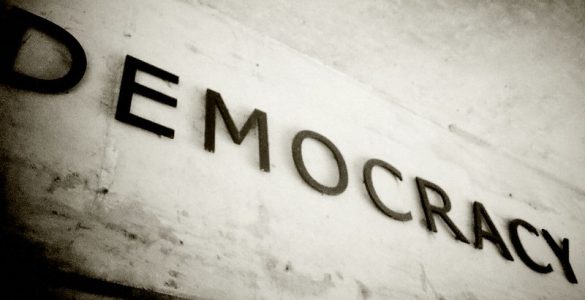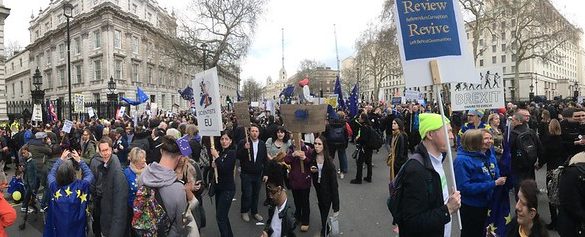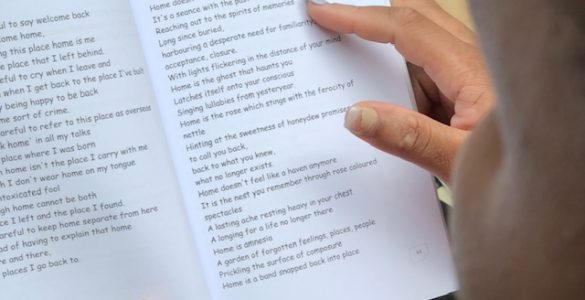Mel Evans, Emma Hughes, and Ruth Potts
We write as three individuals who are part of the group that became known as the Stansted 15 (S15), wrongfully prosecuted for stopping an unlawful Home Office deportation charter flight from taking off. We are writing in response to an article by Graeme Hayes, Brian Doherty and Steven Cammiss, ‘Disciplinary Power and Impression Management in the Trials of the Stansted 15’, published open access on 11 November 2020 in Sociology, a week before the appeal of our conviction under terror-related legislation was heard at the Court of Appeal.
… the authors have not only misunderstood our activism, but have contributed to reinforcing the very structures of power we were working to undermine
We disagree fundamentally with the authors’ central findings, and consider that they failed to meet appropriate ethical standards in conducting their research in relation to the subjects of their study: a group of people facing serious, potentially life-altering charges in an unprecedented criminal trial. The authors’ description of their methodology as ‘ethnographic’ creates the impression that their research yields insights into S15 strategy, behaviour and subjectivity which are not otherwise available in the public domain. However, the authors have not only misunderstood our activism, but have contributed to reinforcing the very structures of power we were working to undermine.
Our actions at trial, viewed as an extension of our activism in solidarity with a group of asylum seekers facing deportation, sought to maintain the focus on the UK government’s actions and its impacts on non-citizens as a way of problematising the notion of citizenship, to whom it is granted and by whom. The authors, in contrast, construct our trial as being about ‘us’ as citizens subject to the processes of the state, an event separable from the action we were being tried for, which was about ‘them’, non-citizens at risk of deportation.
Indeed, the motivation for our action – namely that of protesting the hostile environment, stopping deportations and preventing the removal of individuals due to be on the flight we stopped – is barely mentioned in the article, which fails to make any connections between our actions on the tarmac and our actions in the courtroom. Had the authors undertaken a sustained and thorough ethnography, it would have been difficult for them to come to conclusions which so fundamentally misconstrue our motivations.
Further, we argue that the authors’ conclusions are potentially dangerous for activists who might find themselves in a similar situation, facing serious criminal charges for protesting, especially in the context of new government legislation in its Police, Crime and Sentencing Bill designed to further criminalise protest. As researchers ourselves, we offer this critique of their methods and conclusions in the hope that it will inform the authors’ future research and to encourage broader critical reflection among academic and activist communities.
Compliance and Resistance in the Courtroom
The authors contend that courts are viewed by activists as a place where they can ‘speak truth to power’, but we never viewed it as that. For us, the courtroom was a place where we were, at times, able to centre the brutality of the UK’s deportation and detention regime, but it was not the most significant place where we did that. Far more meaningful for us were events like the demonstration outside the Home Office the day after the verdict, where thousands of people protested against the government’s brutal hostile environment, and defendants spoke – in terms of their choosing – about the action and the issue. Our trial provided a rationale for commentators and academics, including Hayes et al., to explore the issues of border brutality and charter flight deportation in print, blogs and broadcast media. By failing to acknowledge the wider political context and the public arena in which the trial played out, the authors construct the trial as not ‘about’ these issues.
They interpret the fact that people weren’t imprisoned as being reflective of the intention of the state, rather than a position that the state was forced into
Hayes et al. refer to their previous analysis of the Heathrow 13, who were told to expect a three-month jail sentence for aggravated trespass by a judge who later handed down community orders. They fail to recognise that rather than “disarming radical critique so that leniency can be applied”, it was the work of the social movement around those defendants that generated so much media attention on their prospective imprisonment that the judge felt unable to hand down the harsher sentence she had previously committed to deliver. They interpret the fact that people weren’t imprisoned as being reflective of the intention of the state, rather than a position that the state was forced into. We argue the opposite: that the tactics of activists during our trial both inside and outside the courtroom, are precisely what ensured we avoided jail time, just as in the case of the Heathrow 13.
The authors fail to understand the shifting circumstances in which activists operate and deny the possibility that social movements are able to influence what happens. In a later piece, they assert that our victory at appeal was limited because AMSA (the Airport and Maritime Security Act 1990, a ‘Convention offence’ for the purposes of the Terrorism Act 2006) had never been used against activists before. The victory was important precisely because it meant that AMSA couldn’t be used again (several people had already been charged under AMSA after our conviction), and because of the light it shone on the criminalisation of protest, particularly migrant solidarity. The outcome was important, but so was the process. Hayes et al. dismiss both.
They fail to examine the offence we were charged with in any detail. They consider this a ‘standard’ protest case, exploring only the necessity defence which is frequently used in protest cases. But for the Stansted 15 it was not our central defence (and indeed not the ground that we successfully argued on appeal). The necessity defence enabled us to explain in court why we did what we did. The other central pillar of our defence was that AMSA should never have been used in what was clearly a protest case, and was an attempt to escalate the criminalisation of migrant solidarity. As the Lord Chief Justice wrote “the appellants should never have been prosecuted under this extremely serious offence….There was in truth no case to answer”.
Put simply, our case was markedly different from most protest cases, the penalties we faced were markedly different, and the legal strategies we pursued had to be markedly different.
Instead of acknowledging this context, Hayes et al. describe our actions through the lens of ‘script compliance’. This is Zoettl’s (2016) notion that “the defendant’s body plays an important part in the validation of criminal procedure through disciplinary ‘script compliance’: the unspoken rules that regulate bodily posture and movement serve to ‘visually acknowledge the court’s authority to deliver a sentence over the person accused and thus the validity of the sentence itself’”. Hayes et al. argue that the defendants’ dress, body language, and behaviour were examples of this alleged disavowal of our own agency and political identity, and consequent acceptance of the court’s rulings and sentencing.
The authors fail to differentiate between what was said in the courtroom, and how it was said. The politics of our action were displayed in the courtroom. Multiple images of the defendants wearing sweatshirts bearing the words “no-one is illegal” and “mass deportations kill” were on display, while video footage replayed the chants “no borders, no nations, stop deportations”. Looking back from the witness stand at our co-defendants, we often saw half-hearted attempts at public presentation with slouching or belligerent body language towards the court, coats slung across chairs and the witness box in disarray.
Defendants who took the witness stand were admonished by the judge for being ‘political’ as they sought to explain the cruelty of the deportation and detention regime to the jury. They may not have used the words “abolition” or “dismantling the border regime” but their testimony was entirely congruent with those positions. The accounts were simply rendered intelligible to those outside elite groups of activists through their choice of language.
The authors single out the behaviour and language of Mel Evans, an author of this response who self-represented in court, as emblematic of ‘script compliance’. Yet Evans’ ‘behaviour’ in court produced a range of immediate outcomes which could as easily be argued to be effective resistance to the court and government. As a self-representing defendant, Evans was the only member of the legal defence team able to elicit admission from a police officer that officers had instantly recognised the Stansted 15 to be protesters rather than people intent on violence. Evans also succeeded in confirming that our concerns regarding the Home Office’s unlawful deportation was something we had discussed with officers. These are defence claims which otherwise would have remained unconfirmed by any prosecution witness.
Rather than engaging with these points, the researchers support their construction of ‘script compliance’ with quotes from interviewees, including “I really regret that…So everyone was disciplined and to not, like, have a reaction when the verdict happens.” This quote reveals suggestive questioning on the part of the researcher. ‘That’ presumably refers to the proposition put to the interviewee, which Hayes et al. do not quote or contextualise in their piece. We think it unlikely that interviewees would have spontaneously used the word ‘disciplined’ without it being put to them by Hayes et al.. Furthermore, the depiction is inaccurate: there were loud and expressive responses to the verdict from the dock, recorded in several media articles penned by defendants which the authors appear to have failed to cross reference with the quote they employ for the purposes of their article.
Matsuda’s point is precisely that activists who call for the dismantling of laws nonetheless need to strategically engage with law on its terms in order to survive when its violence is being directed against them
Further, Hayes et al. misinterpret academic commentators de Noronha and Chowdhury, implying their analysis is that “defendants have (at least potentially) considerable agency to engage the court ‘as a space in which to air a radical critique’.” In fact de Noronha and Chowdhury are citing Mari Matsuda (1988: 8) here, whose point is more complex: “There are times to stand outside the courtroom door and say ‘this procedure is a farce, the legal system is corrupt, justice will never prevail in this land as long as privilege rules in the courtroom.’ There are [also] times to stand in the courtroom and say, ‘this is a nation of laws, laws recognizing fundamental values of rights, equality and personhood.’” Matsuda’s point is precisely that activists who call for the dismantling of laws nonetheless need to strategically engage with law on its terms in order to survive when its violence is being directed against them. In reference to our case, de Noronha and Chowdhury were recognising the need to defend the human rights of others in a criminal court, rather than bluntly dismissing the court process itself as a political farce, as Hayes et al. invite their readers to do.
The authors conclude, “We see these trials therefore as a normalising procedure whose goal is not the repressive application of custodial sentences, but rather a disciplinary disarming of radical critique so that leniency can be applied.” This is a dangerous lesson to be drawn from our trial. There are many reasons why we didn’t receive a jail sentence: the brilliant work of our lawyers, our own actions and tactics in court, the huge public scrutiny the trial received, and the broad public support from establishment figures to ‘ordinary’ members of the public. The Frack Free Three – jailed for Obstruction of the Highway, a lesser charge, in the opening days of our trial (a sentence later reduced as excessive following a political campaign and highly resourced legal appeal) – showed that without media attention many judges are only too willing to hand out prison sentences.
Centring Whiteness and Activism
The analysis described above ignores the particular concern of the Stansted 15 to focus the story of our trial in the public arena on people bearing the brunt of the Home Office’s racist and frequently unlawful immigration system, rather than on ourselves. The attention the authors paid to our dress and courtroom behaviour misinterpreted our agreed intention to avoid drawing negative public attention onto us as ‘deviants’ which could be reflected back on migrants whose precarity makes them much more vulnerable to the state. Any dramatic resistance to court procedures would have drawn attention to us, rather than the people whose lives were on the line through brutal treatment at the hands of the government. The authors’ analysis fails to grasp this crucial aspect of our strategy, and instead serves to subvert this strategy and draw attention to us rather than those with whom we acted in solidarity.
Hayes et al. therefore do not recognise that the decentring of whiteness was fundamental not only to the actions for which we were charged, but also to the approach we took in courtroom testimonies, the media and at public rallies. For Hayes et al., as for the UK Home Office, the deportees are not subjects, and what this trial is about is a domestic drama of protest regulation played out by liberal subjects, defined implicitly as white citizens.
Rather than substantiating their claim that the Stansted 15 became the ‘ideal disciplined liberal subject’, their analysis relies on a white, macho projected ideal of their perfect political activist. They establish a critical frame of our supposed presentation as ‘caring activists’. This in itself is a misogynist critical frame which, in failing to see or understand the political power of ‘care’, itself reinforces the dominant neoliberal frame in which it is considered irrational, or not even possible, to care for those outside immediate kinship groups.
… the people due to be forced onto the plane do not appear as characters at all
Their ideal, implicitly white, citizen, macho-heroic political activist seemingly cares only about the performative politics of self-expression, and not the impacts of such on others. This mythologised figure is part of the metropolitan liberal elite, and his performativity and blindness to the impacts of his actions is deeply neoliberal and conservative in nature. For Hayes et al. this character of the activist is central – the people due to be forced onto the plane do not appear as characters at all.
The authors misread our actions as much as they misread us. The heroes of the authors’ imaginations are also, implicitly, part of an urban liberal elite. They wrote that Chelmsford seemed alien to us. The reality is we walked the streets commenting on how much it was like the towns we grew up in – Epsom, Croydon and Stockport. They claimed not to want to explore intersectionality ‘because that would be a much bigger job’, but made assumptions about our race and class that didn’t bear any relation to reality, lumping us all in a blanket ‘from London’, ‘estranged by working class people’ when that would be an analysis only applicable to, at most, one or two defendants.
They made a very obvious error stating ‘only two of the defendants were non-white’, strange given their declared constant presence in the courtroom for them to fail to see colour in the defendants’ box. There were three people of colour in the group, as well as a number of identities differing to ‘white English’ including Romany, Spanish, Irish and Jewish, with obvious connections to issues of migration and asylum. Multiple defendants testified to being the first person in their family to go to university, and the actual class backgrounds of the group stretch widely across society’s demographics.
The authors state that they ‘have not fore-grounded questions of intersectionality in our analysis, not because we think they are unimportant (indeed, they are likely to be central to further work on protest trials), but because our primary focus here is on the situational relationship between defendants, individually and as a collective, and other actors in the court’. It is deeply questionable to what extent the authors can meaningfully engage in questions of power, subjectivity and situational relationship while failing to contend with intersectional dimensions of gender, race, and class.
Instead, they note that some of us wore remembrance poppies in court, or made reference to holidays, and describe these as attempts to normalise ourselves in the eyes of the jury, as part of their so-called script compliance. They fail to countenance that a) many of us might actually be ‘normal’ as such (see ‘Give Up Activism’, Andrew X, 1999) and that b) it is a valid political strategy in any trial, activist or otherwise, for a defendant to build on possible points of commonality with a jury rather than merely railing at or against them.
… all effective activism relies on its ability to build commonality with others
It is arguable that all effective activism relies on its ability to build commonality with others. This is not hollow performative allyship, but a recognition that change requires the development of coalitions of shared interests. In attempting to connect with the people due to be on the plane, with the jury and with a broader public through media coverage of the trial, it was such a commonality of interests that the defendants were attempting to create. The researchers use these examples to fortify their depiction of our script compliance, and in so doing they fail to see the potential resistance of these acts: the invitation to care about other ordinary people like ourselves – in all of their complexity – such as those due to be forced onto the plane we lay underneath.
Conclusion
The core issue, we contend, is not as the authors conclude, ‘the transformation of the transgressive activist into the ideal disciplined liberal subject’. Far from it. We identify multiple and creative assertions of agency within the confines of the court process, constantly shifting balances of power in the courtroom in spite of what was at stake. These include the dynamic interplay of coercion and resistance, the multiple identities inhabited by defendants, legal team, jurors and judge and the politics of the “caring activist”. Given these strategies ultimately resulted in our success at appeal, as well as significant public discussion of the issues we sought to draw attention to on multiple occasions it may now be clearly evident that there were a great number of strengths in this approach.
We close by drawing on feminist legal critique and its fundamental lesson: Don’t victimise the victim. It does not assist those who have been subject to a greater power, state or otherwise, to merely emphasise their victimhood without any scope for empowerment and resistance. In this case, the very moments the authors define as our subjugation also contained our greatest resistances. It is much more accurate and interesting, we contend, to consider how coercion and resistance operated within the same moments. Moreover, the authors assume that we accepted the court’s authority to pass judgement on us, an authority we challenged every step of the way and more fundamentally never accepted.
The flawed methods of Hayes et al. meant that they couldn’t see, let alone understand what was happening inside the courtroom and its impacts and ramifications in the wider political arena. We have raised significant questions regarding their outdated and limited ethnographic methodologies that treat participants as the ‘objects’ of research, rather than participants in the research process. The intention of the researchers showed scope for a nuanced account of a protest trial from which valuable conclusions could have been drawn, contributing to academic understanding of agency and of value for the wider movement. Theirs however simply wasn’t it.
References:
Hayes Graeme, Cammiss Steven, Doherty Brian (2021) ‘Disciplinary Power and Impression Management in the Trials of the Stansted 15’, Sociology, 55(3):561-581. doi:10.1177/0038038520954318. Published online first, November 11, 2020
Matsuda, Mari J. (1989) ‘When the First Quail Calls: Multiple Consciousness as Jurisprudential Method. A Talk Presented at the Yale Law School Conference on Women of Color and the Law, April 16, 1988’, Women’s Rights Law Reporter, ll (1): 7-10.
Mel Evans has a BA in Sociology and Theatre Studies from the University of Glasgow, is author of Artwash: Big Oil and the Arts (Pluto: 2015), has chapters in The Routledge Handbook of Radical Politics (Routledge: 2019) and ArtWork: Art, Activism and Labour (Rowman and Littlefield: 2018), and multiple articles published in peer reviewed journals including Performance Research and the Scottish Journal of Performance as part of art-activist collective Liberate Tate.
Emma Hughes has a PhD in Media and Communications from the University of Cardiff and worked for four years as a Research Associate at Cardiff University. She has multiple articles published in peer reviewed journals (e.g Environmental Politics, Journal of Public Affairs), including on the representation of protest.
Ruth Potts has a BA in Modern European History from Warwick University, an MSc in Latin American Politics from the University of London, previously a senior lecturer in Ecological Design Thinking, Schumacher College and is a co-author (with Dr Jyotsna Ram) of an essay in Asylum for Sale: Profit and Protest in the Migration Industry (PM Press: 2020).
All images, credit: Kristian Buus
TO CITE THIS ARTICLE:
Evans, Mel, Emma Hughes and Ruth Potts 2021. ‘The Making of Critical Knowledge Claims: Research, ‘Allyship’ and Politics of Representation’ Discover Society: New Series 1 (3):
Appendix: Methodological concerns, ethics and potential harm of research
The research methods Hayes et al employed raise important questions about ethnography. In the fields of sociology and anthropology, ethnography is a rightly contested practice in which practitioners debate the ethics of both methodology and the positionality of researchers in drawing conclusions about their subjects. The authors assert theirs is “the first ethnographic account of a protest trial.” However, we argue that this claim is wholly unearned. The authors infer they had special access to the inner workings of the S15 trial strategy, presumably by building relationships of trust with us, their informants and subjects. In fact, their methods consisted mainly of court observations supplemented by short interviews with only half of the defendants, under conditions which were arguably constrained and unethical. Their flawed methods meant they were not able to understand the reality of what took place in the courtroom, let alone draw out wider implications of our trial and defence strategy.
The authors claim to have produced an account of the “internal dynamics” of a “protest trial” yet they were privy to none of the “internal dynamics” of our trial. They did not attend a single group meeting, any of the multiple daily meetings with our legal team, the media team meetings, the support group meetings. Nor did they engage with us beyond pleasantries or casual conversation in the court’s public waiting room. This is why the article relies so heavily on the testimony we delivered in the open courtroom.
Although they approached some – but crucially, not all – individual defendants in an ad-hoc way requesting ‘a chat sometime’, at no point did they seek a meeting with the whole group, or distribute copies of their information sheet and consent form to all defendants, which would have been easy to do at any point during the eleven-week period they were present at Chelmsford Crown Court. The authors sent two emails about their research to individual defendants and a defendant group email address; we deem this as a totally inadequate explanation, failure of a duty of care and, at best, a half-hearted attempt to seek full group consent, as they should have. Both emails were missed by most defendants in the deluge of emails regarding our case, and received no reply from the entire group.
As the three of the defendants whose actions the authors cite the most, it is notable that during the eleven weeks of our trial/s, the authors did not once engage any of us in a single conversation. Although they asked Ruth and Mel for interviews (at a time when we were just about to enter the courtroom), Emma was never asked for an interview or spoken to directly by the authors. The authors’ research was never introduced or explained to Emma during the eleven week duration of both trials. Some of the eight out of 15 defendants who did provide an email address to be contacted about the research were emailed an information sheet, but without direct reference to the need to sign a consent form. Three of the eight interviews seem to have consisted of single 45-minute meetings, with only one person being interviewed twice; two of what are presented as interviews were taken from a public presentation made by two defendants.
There is confusion for several defendants who spoke to the authors: one appears to have been considered an interview for the purposes of the article but the defendant interviewed thought it was about something else, and two wonder if court waiting room conversations were considered interviews. The three formal interviews were arranged in cafes during or immediately after the trial. Seven out of eight of the defendants considered to be participants have no recollection of signing a consent form, and the single defendant who did sign a form did so in July 2017, for an earlier, different, piece of research, separate from their second interview following trial which presumably provided the bulk of material for the article. Following a Freedom of Information request, the School of Languages and Social Science Research Ethics Committee at Aston University, which approved the research, refused to, or could not, provide documentation to show how many participants had given informed consent for this research.
The informed consent of the entire group was never sought. In their research outline sent to those who gave interviews, the authors state “It is up to you whether you decide to participate or not”, but also that “informed consent will not be sought where action is undertaken, or opinion expressed, in non-confidential public actions.” However, their research is dependent on observations, described as ethnographic, of all S15 members and while interviewees are granted anonymity in the published article, defendants who gave evidence are not. The failure to seek the participation of the whole group meant that the possibility of deeper engagement and a process of reviewing the findings ‘with’ the participants was precluded.
We were 15 people with different perspectives, backgrounds and present situations which meant we inevitably had contrasting perspectives on the legal strategies being pursued. These differences were discussed at length by the group and understood by all of us, including the fundamental difference between those who gave evidence and those who did not. The authors’ failure to understand us as both individuals and a group is demonstrated most clearly in their inaccurate depiction of who testified during the trial. Of the seven defendants who testified, not one of them was interviewed by the researchers. Hayes et al. assert that “The eight with prior convictions did not give evidence, dispossessing them of their expressive autonomy, and denying them an opportunity to resist the framing of the trial narrative, for the entirety of proceedings. This also had a broader political effect, hiding the wider political connections and histories of more than half the defendants.”
This statement is not correct. The three authors of this response have multiple previous trials or convictions related to acts of protest, and all of us testified. Several of the defendants who testified referred specifically to their previous convictions on the witness stand. One of the three of us has such a long list of misdemeanours that the prosecution spent a full hour outlining them at sentencing. This example demonstrates how Hayes et al feel confident to draw sweeping conclusions about us, our trial and the broader political impacts of it based on insubstantial evidence and basic errors.
These conclusions include that “the defendants’ self regulating calibration to the disciplinary regime of the courtroom served to limit their subjectivity and obscure their political motivations” and “the defendants performed their participation in court in highly legalistic, non-transgressive, ways”. Further, they write that “combining macro and micro approaches” reveals “the interplay of agency and structure in situ”, “providing important insights into how actors make sense of their social world, and how agency is constrained by structure.” Not only did they fail to understand our sense making, but this failure produced partial and flawed analysis that failed to adequately position the ‘micro’ context of the ‘disciplinary regime of the courtroom’ with ‘macro’ considerations of racialised power that structured our participation in the courtroom as part of our wider political goals.
The research received ethical approval from the School of Languages and Social Science Research Ethics Committee at Aston University, and the authors claimed “The study is designed to adhere to the guidelines set out in the British Sociological Association’s Statement of Ethical Practice”. A Freedom of Information request revealed that the Committee paid scant attention to the ethical approval process. There was no formal confirmation letter of ethical approval nor was there a meeting of the Ethics Committee. In fact, ethical approval was granted in a rush over a weekend in correspondence with one colleague, evidently a familiar relationship, in a chain of emails titled “Ethics emergency!”
In this email chain there is no discussion of the serious criminal proceedings we faced, nor any regard given to the potential impact of the research on participants. The ethical approval appears to have been dismissed as paperwork, with one correspondent protesting “it seems…rather bureaucratic and unnecessary…and inappropriate for our discipline.” They agree a “soft version” is sufficient. The overwhelming concern seems to have been with the researcher’s career rather than the participants’ safety, epitomised by the prioritisation of research outputs: “If they could withdraw at a very late stage, it could fuck up any publication.” The authors did not offer to share their prospective publication with us for comment and, in fact, they published it online with no prior warning a week before our appeal was heard at the Court of Appeal at the Royal Courts of Justice
We question whether full consideration was given to the vulnerability of the participants in view of the serious criminal charges they faced, and the implications of conducting (and publishing) the research while the criminal proceedings were ongoing. Defendants were experiencing extreme anxiety and distress. Our physical and mental health, relationships and jobs were all put under incredible strain by the trial process and potential custodial sentence. Rather than have this position of vulnerability recognised and treated with appropriate levels of care, we were turned into two-dimensional research objects in the authors’ empirical engagement with us and in their published article.
The authors do not consider the personal impacts of the trial and threat of serious punishment, be that fear and anxiety or the loss of employment, homes and relationships experienced by some of the defendants over the course of the trial, despite these being the three pillars of many people’s lives, which prison is designed to deny and disrupt. Our lawyers had told us to prepare for a significant custodial sentence following the imprisonment of the Frack Free Three on lesser charges immediately before the start of our second trial. No consideration is given to whether and how the researchers’ presence and research activity, including note-taking and interviews, might have influenced the defendants’ experience of the trial and perspective on the defence strategy, or how their lines of questioning, and selection – intentional or otherwise – of only those defendants who didn’t give evidence – might have contributed to discord within the group.
Research often fails to do what it sets out to achieve and researchers who have set out complex methodologies in theory scale back their methods in practice. This is acceptable so long as the methods deployed are not disingenuous or harmful, and the research aims and conclusions are set out clearly and correspond to one another. The participant information sheet stated “We will ensure that the study is conducted according to ethical principles structured around our duty of care to participants, and that no harm will come to any participant as a result of their participation in the research.”
In our view, harm has been done through this research on a number of levels. Firstly, the defendants who participated in the research were treated as the ‘perfect neoliberal research subjects’ – sources of data and not people. They were given consent forms and information sheets for what appears to be a previous research project and rather than being taken seriously, participants right to withdraw from the research was to viewd by the researches as a threat which could “fuck up publication’. Harm was inevitably done to the internal process of the group of defendants as the researchers separated defendants from the group as subjects to be interrogated and drawn by lines of questioning, potentially disrupting carefully navigated strategies. Harm was done to the wider community of activists facing protest trials and their collective understanding of the very real risks posed to their liberty. Finally, harm was done to the academic and wider political and intellectual community’s understanding of the political strategy of the Stansted 15 defence in relation to the protection of the human rights of non-citizens.
The decision to fully attribute statements made in court is also ethically questionable. While technically the court transcripts can be publicly accessed, the authors have significantly amplified the visibility of the defendants’ names and statements without the prior consent of those defendants. While this is technically permissible, it suggests a lack of compassion and regard for the defendants, particularly as minimal attempt was made to interview the named defendants, or to explain the context in which their words and actions were to be analysed, for instance by way of an Information Sheet distributed among all members of the Stansted 15.
A more ethical, and also, we suggest, productive approach would have been to fully engage all participants, and to discuss their analysis with us. Such an approach is not uncommon in ethnographic research, particularly where the researcher has a relationship with participants. While the authors may claim this would have harmed their independent analysis, it would in fact have enabled them more effectively to consider our actions at trial through a better understanding of our strategies and motivations.









